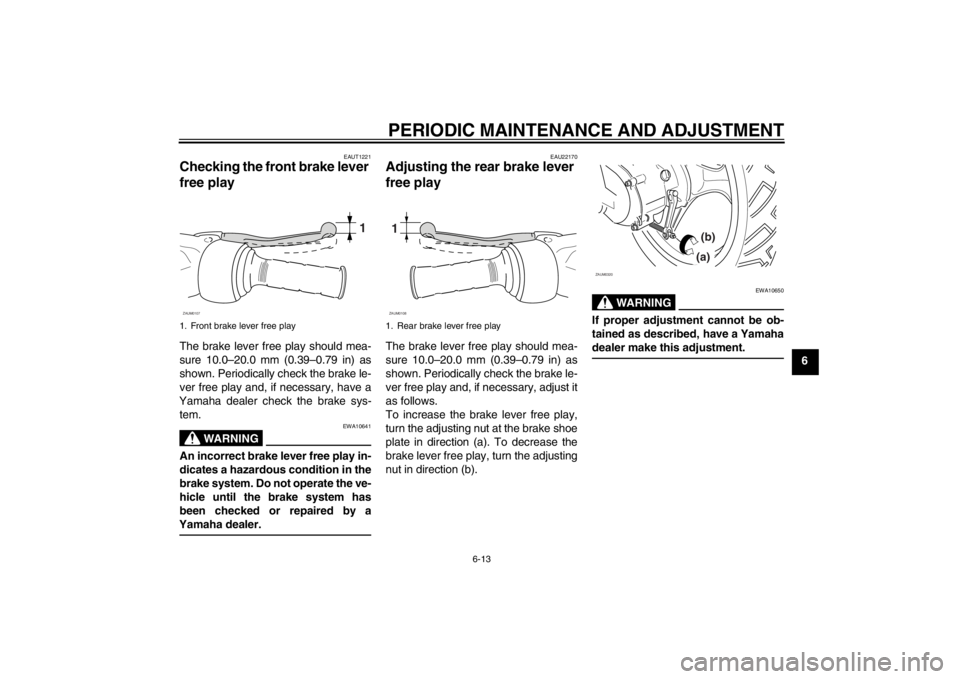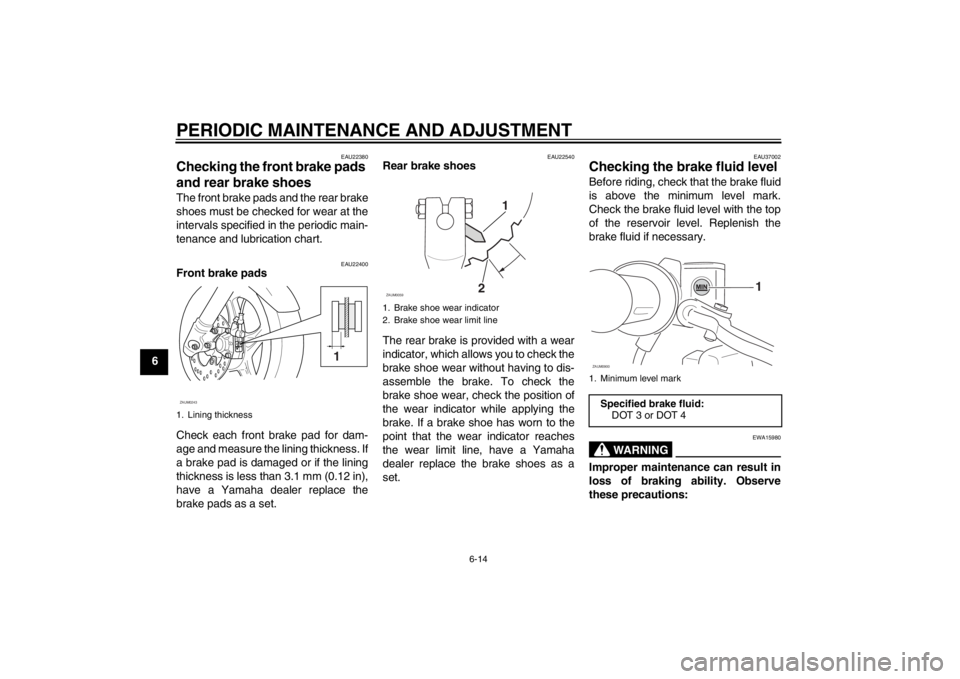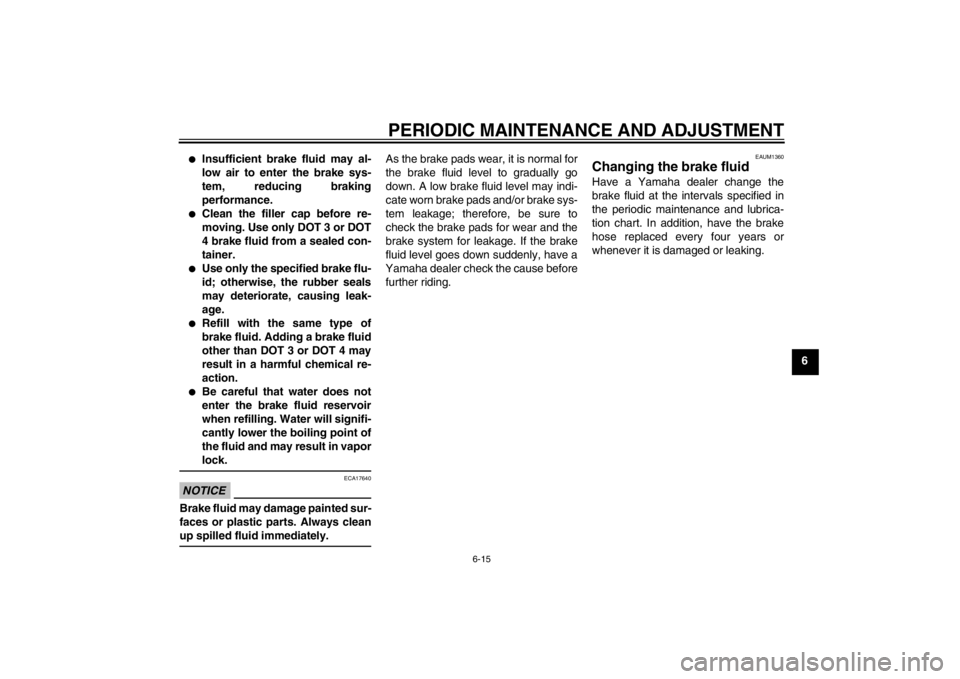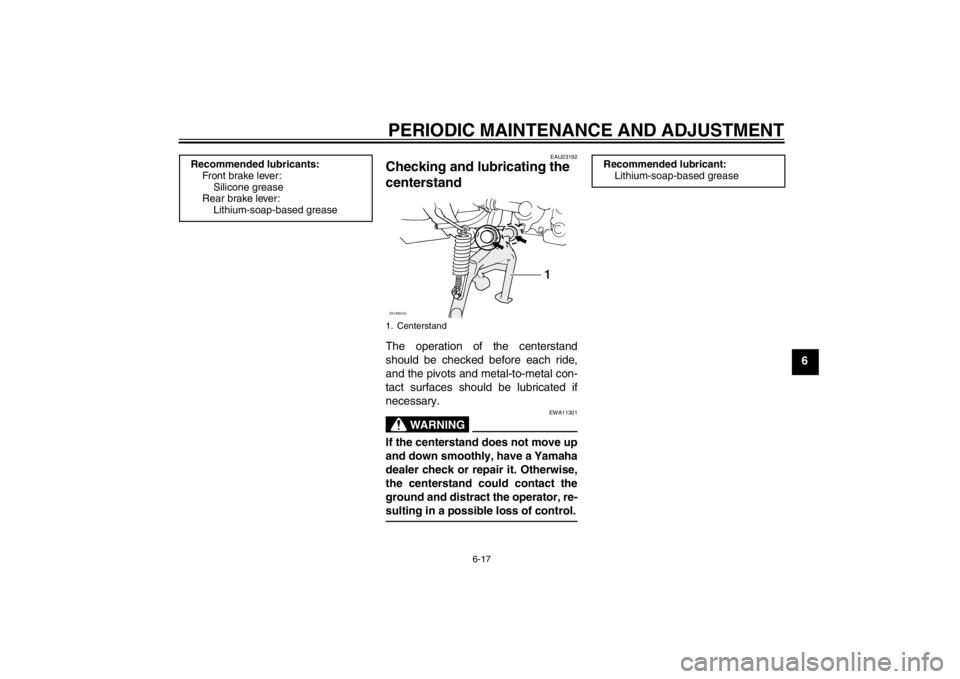2013 YAMAHA SLIDER 50 maintenance
[x] Cancel search: maintenancePage 45 of 66

PERIODIC MAINTENANCE AND ADJUSTMENT
6-13
6
EAUT1221
Checking the front brake lever
free play The brake lever free play should mea-
sure 10.0–20.0 mm (0.39–0.79 in) as
shown. Periodically check the brake le-
ver free play and, if necessary, have a
Yamaha dealer check the brake sys-
tem.
WARNING
EWA10641
An incorrect brake lever free play in-
dicates a hazardous condition in the
brake system. Do not operate the ve-
hicle until the brake system has
been checked or repaired by a
Yamaha dealer.
EAU22170
Adjusting the rear brake lever
free play The brake lever free play should mea-
sure 10.0–20.0 mm (0.39–0.79 in) as
shown. Periodically check the brake le-
ver free play and, if necessary, adjust it
as follows.
To increase the brake lever free play,
turn the adjusting nut at the brake shoe
plate in direction (a). To decrease the
brake lever free play, turn the adjusting
nut in direction (b).
WARNING
EWA10650
If proper adjustment cannot be ob-
tained as described, have a Yamaha
dealer make this adjustment.
1. Front brake lever free play
1
ZAUM0107
1. Rear brake lever free play1ZAUM0108
(a)(b)
ZAUM0320
U1S0E1E0.book Page 13 Wednesday, November 7, 2012 3:32 PM
Page 46 of 66

PERIODIC MAINTENANCE AND ADJUSTMENT
6-14
6
EAU22380
Checking the front brake pads
and rear brake shoes The front brake pads and the rear brake
shoes must be checked for wear at the
intervals specified in the periodic main-
tenance and lubrication chart.
EAU22400
Front brake pads
Check each front brake pad for dam-
age and measure the lining thickness. If
a brake pad is damaged or if the lining
thickness is less than 3.1 mm (0.12 in),
have a Yamaha dealer replace the
brake pads as a set.
EAU22540
Rear brake shoes
The rear brake is provided with a wear
indicator, which allows you to check the
brake shoe wear without having to dis-
assemble the brake. To check the
brake shoe wear, check the position of
the wear indicator while applying the
brake. If a brake shoe has worn to the
point that the wear indicator reaches
the wear limit line, have a Yamaha
dealer replace the brake shoes as a
set.
EAU37002
Checking the brake fluid level Before riding, check that the brake fluid
is above the minimum level mark.
Check the brake fluid level with the top
of the reservoir level. Replenish the
brake fluid if necessary.
WARNING
EWA15980
Improper maintenance can result in
loss of braking ability. Observe
these precautions:
1. Lining thickness
1
ZAUM0243
1. Brake shoe wear indicator
2. Brake shoe wear limit line
1
2
ZAUM0059
1. Minimum level markSpecified brake fluid:
DOT 3 or DOT 4
1
ZAUM0900
U1S0E1E0.book Page 14 Wednesday, November 7, 2012 3:32 PM
Page 47 of 66

PERIODIC MAINTENANCE AND ADJUSTMENT
6-15
6
●
Insufficient brake fluid may al-
low air to enter the brake sys-
tem, reducing braking
performance.
●
Clean the filler cap before re-
moving. Use only DOT 3 or DOT
4 brake fluid from a sealed con-
tainer.
●
Use only the specified brake flu-
id; otherwise, the rubber seals
may deteriorate, causing leak-
age.
●
Refill with the same type of
brake fluid. Adding a brake fluid
other than DOT 3 or DOT 4 may
result in a harmful chemical re-
action.
●
Be careful that water does not
enter the brake fluid reservoir
when refilling. Water will signifi-
cantly lower the boiling point of
the fluid and may result in vapor
lock.
NOTICE
ECA17640
Brake fluid may damage painted sur-
faces or plastic parts. Always clean
up spilled fluid immediately.
As the brake pads wear, it is normal for
the brake fluid level to gradually go
down. A low brake fluid level may indi-
cate worn brake pads and/or brake sys-
tem leakage; therefore, be sure to
check the brake pads for wear and the
brake system for leakage. If the brake
fluid level goes down suddenly, have a
Yamaha dealer check the cause before
further riding.
EAUM1360
Changing the brake fluid Have a Yamaha dealer change the
brake fluid at the intervals specified in
the periodic maintenance and lubrica-
tion chart. In addition, have the brake
hose replaced every four years or
whenever it is damaged or leaking.
U1S0E1E0.book Page 15 Wednesday, November 7, 2012 3:32 PM
Page 48 of 66

PERIODIC MAINTENANCE AND ADJUSTMENT
6-16
6
EAU50800
Checking and lubricating the
cables The operation of all control cables and
the condition of the cables should be
checked before each ride, and the ca-
bles and cable ends should be lubricat-
ed if necessary. If a cable is damaged
or does not move smoothly, have a
Yamaha dealer check or replace it.
WARNING! Damage to the outer
housing of cables may result in in-
ternal rusting and cause interfer-
ence with cable movement. Replace
damaged cables as soon as possi-
ble to prevent unsafe conditions.[EWA10711]EAU23114
Checking and lubricating the
throttle grip and cable The operation of the throttle grip should
be checked before each ride. In addi-
tion, the cable should be lubricated by a
Yamaha dealer at the intervals speci-
fied in the periodic maintenance chart.
The throttle cable is equipped with a
rubber cover. Make sure that the cover
is securely installed. Even though the
cover is installed correctly, it does not
completely protect the cable from water
entry. Therefore, use care not to pour
water directly onto the cover or cable
when washing the vehicle. If the cable
or cover becomes dirty, wipe clean with
a moist cloth.
EAU43642
Lubricating the front and rear
brake levers The pivoting points of the front and rear
brake levers must be lubricated at the
intervals specified in the periodic main-
tenance and lubrication chart.
Front brake lever
Rear brake lever
Recommended lubricant:
Yamaha Chain and Cable Lube or 4-
stroke engine oil
U1S0E1E0.book Page 16 Wednesday, November 7, 2012 3:32 PM
Page 49 of 66

PERIODIC MAINTENANCE AND ADJUSTMENT
6-17
6
EAU23192
Checking and lubricating the
centerstand The operation of the centerstand
should be checked before each ride,
and the pivots and metal-to-metal con-
tact surfaces should be lubricated if
necessary.
WARNING
EWA11301
If the centerstand does not move up
and down smoothly, have a Yamaha
dealer check or repair it. Otherwise,
the centerstand could contact the
ground and distract the operator, re-
sulting in a possible loss of control.
Recommended lubricants:
Front brake lever:
Silicone grease
Rear brake lever:
Lithium-soap-based grease
1. Centerstand
1
ZAUM0455
Recommended lubricant:
Lithium-soap-based grease
U1S0E1E0.book Page 17 Wednesday, November 7, 2012 3:32 PM
Page 50 of 66

PERIODIC MAINTENANCE AND ADJUSTMENT
6-18
6
EAU23272
Checking the front fork The condition and operation of the front
fork must be checked as follows at the
intervals specified in the periodic main-
tenance and lubrication chart.
To check the condition
Check the inner tubes for scratches,
damage and excessive oil leakage.
To check the operation
1. Place the vehicle on a level sur-
face and hold it in an upright posi-
tion. WARNING! To avoid injury,
securely support the vehicle so
there is no danger of it falling
over.
[EWA10751]
2. While applying the front brake,
push down hard on the handlebars
several times to check if the front
fork compresses and rebounds
smoothly.
NOTICE
ECA10590
If any damage is found or the front
fork does not operate smoothly,
have a Yamaha dealer check or re-
pair it.
EAU45511
Checking the steering Worn or loose steering bearings may
cause danger. Therefore, the operation
of the steering must be checked as fol-
lows at the intervals specified in the pe-
riodic maintenance and lubrication
chart.
1. Place the vehicle on the center-
stand. WARNING! To avoid inju-
ry, securely support the vehicle
so there is no danger of it falling
over.
[EWA10751]
2. Hold the lower ends of the front
fork legs and try to move them for-
ward and backward. If any free
play can be felt, have a Yamaha
dealer check or repair the steering.
ZAUM0896
ZAUM0897
U1S0E1E0.book Page 18 Wednesday, November 7, 2012 3:32 PM
Page 51 of 66

PERIODIC MAINTENANCE AND ADJUSTMENT
6-19
6
EAU23291
Checking the wheel bearings The front and rear wheel bearings must
be checked at the intervals specified in
the periodic maintenance and lubrica-
tion chart. If there is play in the wheel
hub or if the wheel does not turn
smoothly, have a Yamaha dealer check
the wheel bearings.
EAUM1404
Battery A poorly maintained battery will corrode
and discharge quickly. The electrolyte
level, battery lead connections and
breather hose routing should be
checked before each ride and at the in-
tervals specified in the periodic mainte-
nance and lubrication chart.
To check the electrolyte level
1. Place the scooter on a level sur-
face and hold it in an upright posi-
tion.
TIPMake sure that the scooter is posi-
tioned straight up when checking the
electrolyte level.2. Remove panel A. (See page 6-6.)
3. Check the electrolyte level in the
battery.TIPThe electrolyte should be between the
minimum and maximum level marks.4. If the electrolyte is at or below the
minimum level mark, add distilled
water to raise it to the maximum
level mark. NOTICE: Use only
1. Panel A
2. Fuse
3. Battery
32 1
ZAUM0162
1. Maximum level mark
2. Minimum level mark1
2
+
UPPER
LOWER
ZAUM0106
U1S0E1E0.book Page 19 Wednesday, November 7, 2012 3:32 PM
Page 52 of 66
![YAMAHA SLIDER 50 2013 Owners Manual PERIODIC MAINTENANCE AND ADJUSTMENT
6-20
6distilled water, as tap water con-
tains minerals that are harmful
to the battery.
[ECA10611]
WARNING
EWA10760
●
Electrolyte is poisonous and
dangerous sin YAMAHA SLIDER 50 2013 Owners Manual PERIODIC MAINTENANCE AND ADJUSTMENT
6-20
6distilled water, as tap water con-
tains minerals that are harmful
to the battery.
[ECA10611]
WARNING
EWA10760
●
Electrolyte is poisonous and
dangerous sin](/manual-img/51/51205/w960_51205-51.png)
PERIODIC MAINTENANCE AND ADJUSTMENT
6-20
6distilled water, as tap water con-
tains minerals that are harmful
to the battery.
[ECA10611]
WARNING
EWA10760
●
Electrolyte is poisonous and
dangerous since it contains sul-
furic acid, which causes severe
burns. Avoid any contact with
skin, eyes or clothing and al-
ways shield your eyes when
working near batteries. In case
of contact, administer the fol-
lowing FIRST AID.
EXTERNAL: Flush with plenty
of water.
INTERNAL: Drink large quan-
tities of water or milk and im-
mediately call a physician.
EYES: Flush with water for 15
minutes and seek prompt
medical attention.
●
Batteries produce explosive hy-
drogen gas. Therefore, keep
sparks, flames, cigarettes, etc.,
away from the battery and pro-
vide sufficient ventilation when
charging it in an enclosed
space.
●
KEEP THIS AND ALL BATTER-
IES OUT OF THE REACH OF
CHILDREN.
5. Check and, if necessary, tighten
the battery lead connections and
correct the breather hose routing.
To store the battery
1. If the scooter will not be used for
more than one month, remove the
battery, fully charge it, and then
place it in a cool, dry place.
NOTICE: When removing the
battery, be sure the key is
turned to “ ”, then disconnect
the negative lead before discon-
necting the positive lead.
[ECA16302]
2. If the battery will be stored for more
than two months, check the specif-
ic gravity of the electrolyte at least
once a month and fully charge the
battery whenever necessary.
3. Fully charge the battery before in-
stallation. NOTICE: When install-
ing the battery, be sure the key
is turned to “ ”, then connect
the positive lead before con-
necting the negative lead.
[ECA16840]
4. After installation, make sure that
the battery leads are properly con-
nected to the battery terminals and
that the breather hose is properly
routed, in good condition, and not
obstructed. NOTICE: If the
breather hose is positioned in
such a way that the frame is ex-
posed to electrolyte or gas ex-
pelled from the battery, the
frame could suffer structural
and external damages.
[ECA10601]
U1S0E1E0.book Page 20 Wednesday, November 7, 2012 3:32 PM